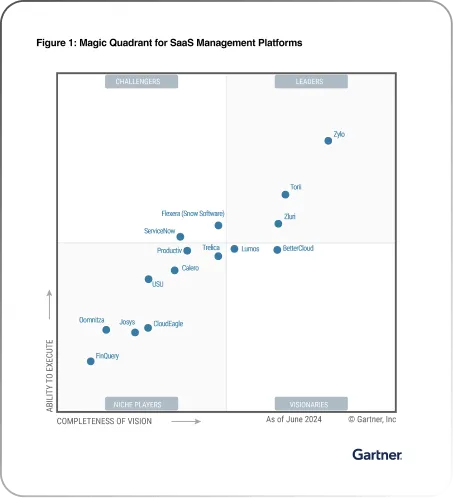Business IT alignment is crucial for CIOs aiming to drive their organizations forward. This article will help you understand every aspect of business and IT alignment.
As a CIO, you've likely faced the challenge of ensuring that your IT strategies are not just supporting but actively driving your business goals. The pain of misalignment between IT and business can result in wasted resources, missed opportunities, and slowed growth.
This misalignment can create frustration within your teams and lead to inefficiencies that ripple across the organization. Departments may struggle to get the tools they need when they need them, or worse, they might invest in solutions that don't integrate well with existing systems. This further impacts the bottom line and can even erode your organization's competitive edge.
The solution lies in achieving true business IT alignment—where technology and business strategies are seamlessly integrated, and IT becomes a driving force behind business success.
Now, we will learn every aspect of business IT alignment including its importance, stages, challenges, and more.
Why is Business IT Alignment Important?
As a CIO, you understand the importance of aligning your IT systems and processes with your organization's overall business goals and objectives. Business IT alignment ensures that your IT department and business units work together seamlessly, moving in the same direction and at the necessary pace.
A Gartner report, "The CIO's Role in Preparing for Digital Business Acceleration," highlights that over 70% of senior leaders see digital technology as crucial for revenue, product development, customer engagement, and improving strategic operations.
In the "2021 Evolution of CIO Responsibilities Survey," Gartner found that 83% of CIOs are increasingly involved in enterprise-level initiatives beyond their traditional IT roles. This shift reflects the growing importance of IT in driving business-wide strategies.
Additionally, a 2021 report by The Economist Intelligence Unit, titled "IT's Changing Mandate in an Age of Disruption," surveyed over 1,000 IT leaders and senior business executives. It revealed that 83% believe significant improvements in IT infrastructure and applications are needed to adapt to external changes.
Further, aligning IT with business goals ensures the organization gets the right technology at the right time, helping to meet key performance indicators and achieve business transformation objectives, whether it's improving customer service or creating new revenue streams.
Benefits of Business-IT Alignment
Here are the key benefits of business IT alignment.
- Improved Communication and Collaboration
Business IT alignment ensures that IT systems and processes are aligned with your organization's overall goals and objectives. This alignment fosters better communication and collaboration between IT and business stakeholders. It leads to more effective decision-making and a more cohesive organization.
- Enhanced IT Service Delivery
When IT systems and processes are aligned with business needs, IT can deliver more relevant and valuable services to the organization. This alignment enables IT to prioritize and focus on the most critical business needs. Further, it results in improved service delivery and a better return on investment.
- Increased Efficiency and Productivity
Business IT alignment helps eliminate redundant and inefficient processes, reduce the errors, and improve overall productivity. Organizations can streamline operations, reduce costs, and improve overall efficiency by aligning IT systems and processes with business needs.
- Better Risk Management
Business IT alignment helps to identify and mitigate potential risks and threats to the organization. By aligning IT systems and processes with business needs, organizations can better manage and mitigate risks, ensuring the security and integrity of their data and systems.
- Improved Compliance and Governance
Business IT alignment ensures that IT systems and processes comply with relevant regulations and standards. This alignment helps ensure that your organization complies with regulatory requirements, minimizing the penalties and fines.
- Enhanced Innovation and Agility
Business IT alignment enables your organization to respond quickly and effectively to the changing business needs and market conditions. By aligning IT systems and processes with business needs, organizations can innovate and adapt more quickly. It helps you stay ahead of the competition and driving growth and success.
- Improved Employee Satisfaction and Engagement
Business IT alignment helps to ensure that IT systems and processes are user-friendly and intuitive, improving employee satisfaction and engagement. Organizations can create a more positive and productive work environment by aligning IT systems and processes with business needs.
- Better Decision-Making
Business IT alignment provides IT leaders with a clear understanding of the organization's business needs and goals. This alignment enables IT leaders to make more informed decisions, aligning IT investments and resources with business priorities and objectives.
- Improved IT Budgeting and Resource Allocation
Business IT alignment helps to ensure that IT budgets and resources are allocated effectively, aligning with business priorities and objectives. By aligning IT systems and processes with business needs, organizations can optimize IT budgets and resources, ensuring that they are used effectively and efficiently.
Stages Involved in an Effective Business IT Alignment Cycle
The business IT alignment cycle is a fundamental concept that organizations can use to create alignment between IT and business goals. This cycle includes four stages: plan, model, manage, and measure. These stages help ensure that IT and business objectives are aligned and that there are shared expectations across the organization.
1. Plan: Bridging the Gap
The planning stage focuses on closing the gap between what business management expects and what the IT team delivers. Continuous communication between IT and business leaders is crucial. Moreover, without this stage, IT cannot determine which services to offer or how to manage resources to maximize business value.
As business needs change, IT should adapt its services and resources accordingly. CIOs should implement a rigorous service level management process, ensuring agreements on specific IT services and service levels that meet business goals. IT management can then translate these principles into service definitions and service levels.
Finally, it's essential to measure and track both business-level services and IT support capabilities.
2. Model: Designing for Business Value
In the modeling stage, the goal is to design IT infrastructure to optimize business value. This involves identifying the resources needed to provide IT services at agreed-upon levels. IT assets, processes, and resources are mapped to these services, prioritizing those that support critical business functions.
Effective alignment means IT focuses on projects and tasks that matter most to business leaders. To allocate resources effectively, IT needs a service impact model and a centralized repository for configuration and asset management. This approach helps plan, prioritize, and deliver services consistently while controlling costs.
3. Manage: Driving Outcomes
Managing outcomes involves centralizing service support. CIOs can ensure that all service requests are submitted in one place and prioritized based on predefined business priorities. Without a single point of contact, managing resources to meet service levels is challenging.
The IT team needs mechanisms for prioritizing service requests, structured change management processes to minimize disruptions, and systems for managing IT events that support critical services. These operational measures, along with tools for tracking service level progress, are essential for delivering on promises.
4. Measure: Enhancing Operations
The measurement stage increases the visibility of operations and service level requirements across the organization. Traditional IT management tools often operate in silos, focusing more on technical objectives than business goals.
While component-level metrics are important for maintaining service availability, these metrics must be reviewed in the context of the entire organization. This holistic approach allows for real-time resource allocation decisions and helps ensure that IT services support business objectives.
A business framework for reviewing measures and KPIs is necessary for an integrated view of IT services. By committing to this cycle and integrating processes with technological solutions, CIOs can drive systematic improvements and overcome alignment challenges.
Steps Involved in an Effective Business IT Alignment Process
Aligning business with IT is a process. In this process, there is no start or end point. It is a continuous process to make it a successful alignment. Let's learn the steps involved in an effective business IT alignment.
- Step 1: Identify Business Drivers
The first step in achieving effective business IT alignment is to identify the key drivers of the business. These drivers include the main goals and objectives that your company aims to achieve, such as increasing market share, improving customer satisfaction, or reducing operational costs. Understanding these drivers helps in setting clear priorities for IT initiatives. This alignment ensures that IT efforts are focused on supporting the most critical business outcomes.
- Step 2: Create IT Vision
Next, create a clear IT vision that aligns with the identified business drivers. This vision should outline how IT will support and enhance business goals. It should include long-term objectives, such as improving infrastructure, adopting new technologies, or enhancing data security. A well-defined IT vision provides direction and helps ensure that all IT activities are strategically aligned with the company's overall objectives.
- Step 3: Assess Current Alignment
After establishing the IT vision, assess the current state of alignment between IT and business objectives. This assessment involves reviewing existing IT projects, processes, and systems to determine how well they support business goals. It also includes evaluating the effectiveness of communication and collaboration between IT and business units. This step helps you identify strengths and weaknesses in the current alignment, providing a baseline for improvement.
- Step 4: Identify Alignment Gaps
With the current alignment assessed, the next step is to identify any gaps between IT capabilities and business needs. These gaps can include outdated technology, insufficient resources, or misaligned priorities. Understanding these gaps is crucial for developing a targeted strategy to bridge them. This step involves gathering input from both IT and business stakeholders to ensure a comprehensive understanding of alignment issues.
- Step 5: Prioritize IT Initiatives
Once alignment gaps are identified, prioritize IT initiatives that will address these gaps and support business drivers. Prioritization should be based on factors such as potential impact on business goals, resource availability, and implementation feasibility. This step ensures that the most critical projects are given priority and that IT efforts are focused on delivering maximum business value.
- Step 6: Evaluate Implementation Options
Evaluate different options for implementing the prioritized IT initiatives. This evaluation should consider various factors, including cost, time, resource requirements, and potential risks. Exploring multiple implementation strategies helps in choosing the most effective approach for achieving alignment goals. This step may also involve conducting pilot projects or proof-of-concept tests to validate the chosen options.
- Step 7: Create Migration Plan
Develop a detailed migration plan for implementing the chosen IT initiatives. This plan should outline the steps required to transition from the current state to the desired future state. It should include timelines, milestones, resource allocation, and risk management strategies. A well-structured migration plan ensures that the implementation process is organized and that progress can be tracked effectively.
- Step 8: Adjust IT Strategies
Finally, adjust IT strategies to ensure continuous alignment with evolving business goals. This step involves regularly reviewing and updating IT plans and initiatives based on changes in the business environment. It also includes fostering ongoing communication and collaboration between IT and business units. By staying flexible and responsive, organizations can maintain effective alignment and continue to derive maximum value from their IT investments.
What are the Challenges of IT Business Alignment?
Achieving IT business alignment can be a daunting task, as it requires significant changes to the way your organization operates. Here are some of the challenges you may face when trying to achieve business IT alignment:
- Cultural Barriers: One of the biggest challenges to business IT alignment is the cultural divide between the IT department and the rest of the organization. IT is often seen as a separate entity, with its own language and priorities. This can lead to a lack of understanding and trust between the two groups, making it difficult to achieve alignment.
- Lack of Communication: Another IT business alignement challenge is the lack of communication between the IT department and the rest of the organization. This leads to a lack of understanding of your IT department's capabilities and limitations, as well as a lack of understanding of the business's needs and priorities.
- Inadequate Resources: Inadequate resources, including budget and personnel, can also be a significant challenge to business IT alignment. The IT department may not have the necessary resources to support the business's needs, leading to a lack of alignment and trust.
- Resistance to Change: Resistance to change is another challenge that can hinder business IT alignment. The IT department may be resistant to changing its processes and systems to align with the business's needs, and the business may be resistant to adopting new technologies and processes.
- Lack of Clear Goals: A lack of clear goals and objectives can also be a challenge to business IT alignment. Without a clear understanding of what your organization wants to achieve, it might be difficult to determine what IT systems and processes are needed to support those goals.
- Inadequate Training: Inadequate training can also be a challenge to business IT alignment. The IT department may not have the necessary training and expertise to support the business's needs, leading to a lack of alignment and a lack of trust.
- Inadequate Technology: Inadequate technology can also be a challenge to business IT alignment. The IT department may not have the necessary technology and tools to support the business's needs, leading to a lack of alignment and a lack of trust.
Business IT Alignment Strategies
To overcome the above mentioned challenges, you need to implement alignment of IT and business strategies.
1. Develop a Clear Vision and Strategy
The first step in overcoming the challenges of business IT alignment is to develop a clear vision and strategy. This involves identifying your organization's goals and objectives, and determining how IT can support those goals. This will help ensure that everyone in the organization is working towards the same goals, and that IT is aligned with those goals.
2. Foster a Culture of Collaboration
Fostering a culture of collaboration between the IT department and the rest of the organization is another key strategy for overcoming the challenges of business IT alignment. This involves encouraging open communication, sharing information, and working together to achieve common goals. This can be achieved through regular meetings, training sessions, and other collaborative activities.
3. Provide Training and Development Opportunities
Providing training and development opportunities for IT staff is another important strategy for overcoming the challenges of business IT alignment. This involves providing training and development opportunities that help IT staff develop the skills and knowledge they need to support the business's needs. This can include training on new technologies, processes, and methodologies, as well as opportunities for professional development and advancement.
4. Leverage Technology to Improve Communication
Leveraging technology to improve communication between the IT department and the rest of the organization is another key strategy for overcoming the challenges of business IT alignment. This involves using technology to facilitate communication, collaboration, and information sharing. This can include using collaboration tools, such as project management software, and communication tools, such as instant messaging and video conferencing.
5. Measure and Monitor Progress
Measuring and monitoring progress is another important strategy for overcoming the challenges of business IT alignment. This involves tracking and measuring the progress of IT projects and initiatives, and using that information to make adjustments and improvements. This can include using metrics and key performance indicators (KPIs) to measure the success of IT projects and initiatives, and using that information to make data-driven decisions.
Achieve Business IT Alignment to Optimize Your Operational Efficiency
Business IT alignment is crucial for ensuring that IT initiatives directly support and drive the strategic goals of the organization. By integrating IT and business strategies, fostering clear communication, and enhancing collaboration between departments, CIOs can significantly improve operational efficiency and drive innovation. This alignment helps in creating a competitive advantage, adapting to market changes, and achieving long-term business success.
A key component of successful business IT alignment is effectively managing the vast array of tools and technologies used within the organization. Leveraging a comprehensive tool like Zluri can simplify this process.
Zluri offers a SaaS management platform that identifies and manages your SaaS applications, ensuring they are aligned with your business objectives. This tool offers visibility into IT usage, streamlines operations, and supports strategic decision-making, allowing you to adapt quickly and maintain alignment.
IT-business alignment provides a powerful competitive edge and is crucial for driving enterprise-wide transformation. As a CIO, you have the opportunity to lead this change and pave the way for your organization's success. Start aligning today for a stronger tomorrow.









.svg)





























.webp)







.webp)
.webp)





.webp)